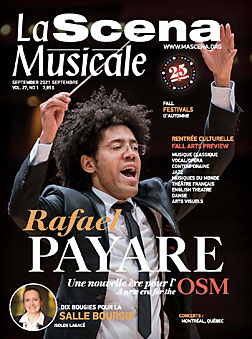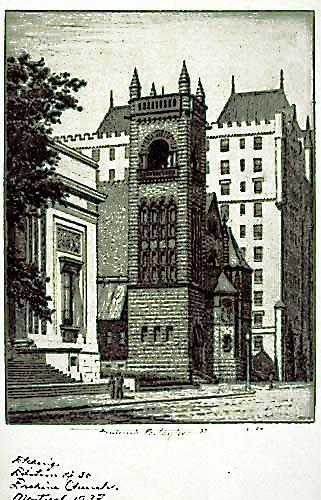
This page is also available in / Cette page est également disponible en:
![]() Francais (French)
Francais (French)
Well established today in the cultural landscape of Montreal, Bourgie Hall was not always a setting for concerts and music making. Since its inauguration in September 2011, recitals, chamber music, vocal music or world music concerts, jazz evenings and even crossover events – many in connection with the collections and exhibitions of the Montreal Museum of Fine Arts – have taken place in the former Erskine and American United Church. Through its evolution and transformations, this place bears invaluable witness to the fate of the various anglophone Protestant communities that were established in downtown Montreal, in the district known as the Golden Square Mile.
 It was in 1893 that the construction of Erskine Church began on Sherbrooke Street at the corner of Crescent. Starting in the following year, it served as a new place of worship for the Presbyterian congregation of Scottish Secessionists, the name given to a dissident Protestant community led in 1733 by Ebenezer Erskine, who decided to immigrate to Canada and settle in Montreal in 1820.
It was in 1893 that the construction of Erskine Church began on Sherbrooke Street at the corner of Crescent. Starting in the following year, it served as a new place of worship for the Presbyterian congregation of Scottish Secessionists, the name given to a dissident Protestant community led in 1733 by Ebenezer Erskine, who decided to immigrate to Canada and settle in Montreal in 1820.
In 1925, the Erskine Church entered the United Church of Canada, which emerged from the amalgamation of several Protestant denominations across the country. Then, in 1934, it in turn incorporated the American Presbyterian Church, which since 1866 had occupied a place of worship not far away, on Dorchester Blvd. (now René-Lévesque). The combined congregation became the Erskine and American United Church.
Following this union there was a thorough renovation of the interior in 1937 and 1938. This renovation, proposed by Percy Erskine Nobbs (1875-1964), a Montreal architect of Scottish origin, notably inlcuded the installation of Tiffany stained glass windows, which greatly enhanced the aesthetic value of the church.
Outstanding stained glass
Designated a National Historic Site in 1998, the church boasts this exceptional set of stained glass windows, most of which have survived. Among the 81 windows that have been restored are 20 stained glass windows commissioned at the turn of the 20th century for the American Presbyterian Church and produced by the workshops of the Tiffany Glass and Decorating Company. This is the largest collection of its kind in Canada and one of the few Tiffany religious collections in North America.
These works are characterized by a glass with a milky hue and iridescent reflections that recall the characteristics of opal. They owe their name to the American artist Louis Comfort Tiffany (1848-1933), who became famous for his work in the Art Nouveau style.
Conversion to a concert hall
Upholding the religious vocation of the building was complicated by the decreasing number of faithful and the high costs of maintenance. The church closed permanently when the congregation merged in June 2004 with that of St. Andrews-Dominion-Douglas. An agreement signed with the Montreal Museum of Fine Arts, which foresaw the possibility of turning it into a pavilion dedicated to Canadian art, breathed a second life into the building.
In 2007, Montreal businessman Pierre Bourgie created the Arte Musica foundation, the objective of which was to create a new concert hall in the heart of the museum. From the start, he entrusted the general and artistic direction to Isolde Lagacé, who already had solid experience in arts management in the Quebec cultural milieu, notably at the Conservatoire de musique de Montréal and at the Schulich School of Music of McGill University.
The old sanctuary was converted into a hall with 467 seats. To this was added work on acoustics, in particular a cherrywood shell and several panels above the stage, in order to create a sound environment worthy of the most beautiful “temples” of music. Laurent Patenaude, artistic director of the chamber orchestra Les Violons du Roy, praises the acoustic qualities of the hall, which he believes foster intimacy. “In Bourgie Hall, you must go farther in pianissimos…The most difficult sounds to make are the very subtle nuances, since the room carries these well, the projection being excellent, natural and very agreeable.”
Musicians at Bourgie Hall can also count on a valuable collection of instruments, including a historic Érard grand piano (1859), a 17th-century Italian-style harpsichord built by Rodney Myrvaagnes (1975), another harpsichord in the 17th-century Flemish style built by Keith Hill (1984), a clavicytherium designed by Yves Beaupré (2002) based on an instrument by Albertus Delin from 1768, as well as two chamber organs, small and large, made by Hellmut Wolff.
Bourgie Hall Special
This page is also available in / Cette page est également disponible en:
![]() Francais (French)
Francais (French)
















